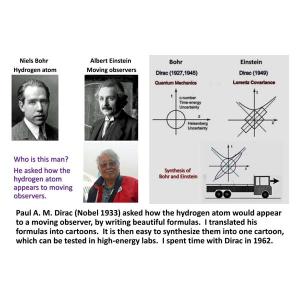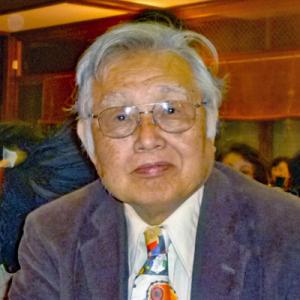Renowned Physicist Dr. Young Suh Kim to be Featured on Close Up Radio
BELTSVILLE, MARYLAND, UNITED STATES, March 20, 2024 /EINPresswire.com/ -- How do the orbits of the hydrogen atom appear to you while you are in motion? Einstein asked this question in the 1950s. In 1978, Dr. Young Suh Kim answered. His paper, "Representations of the Poincaré Group for Relativistic Extended Hadrons" was published by the Journal of Mathematical Physics in 1979. Dr. Kim reflects, "It wasn't Einstein's fault. He didn't have access to high-energy accelerators—but fortunately, we do."
Born in Sorae, Korea in 1935, Dr. Kim shares that the United States has been very good to him. "I could never accomplish all I have in any other country except America." Poverty, political unrest, and cultural norms would have made a life in academia impossible. "Growing up in Korea during the 1950s gave me a solid work ethic. We attended the Sorae Church, which was founded by Horace Underwood, the first American Presbyterian missionary to come to Korea. My grandfather was a very good friend of Underwood's and took care of his properties while Underwood was traveling." Kim explains.
This foundation is what Dr. Kim brought to America in 1954, where he attended Carnegie Institute of Technology (now Carnegie Mellon University). That's where Dr. Kim first learned about Albert Einstein.
"I just knew I had to meet Dr. Einstein, who had worked with Princeton University. In 1958, I was accepted to Princeton and my dream came true (as best it could)," explains Dr. Kim. "Even though Einstein had passed in 1955, I was able to work with him through his research.”
That's when Dr. Kim learned that during the time Einstein formulated his Theory of Relativity in 1905, all particles were considered "point particles," or particles that do not take up space. Later, particles such as the hydrogen atom or the proton, were found to have very rich internal structures that do take up space. This discovery created a problem—how do particles appear when in motion?
Being so close to Dr. Einstein, Dr. Kim had to discover the answer. "While at Princeton, I began studying Dr. Eugene Wigner's 1939 paper titled, 'On Unitary Representations of the Inhomogeneus Lorentz Group.' That's when I discovered a sort of dark period in scientific history."
During the early years of the 20th Century, Niels Bohr was researching the hydrogen atom, while Einstein was studying how particles appear to moving observers. Although the two scientific icons met occasionally to discuss physics, they left no writings on whether or not they discussed how moving hydrogen atoms appear to observers at rest.
After 20 years (1966-1986) of continuous research, Dr. Kim discovered Wigner's 1939 mathematical paper is applicable to the internal space-time structure of particles. When Einstein formulated his theory of relativity in 1905, particles were considered to be "point particles." Later, particles such as the hydrogen atom or the proton, were found to have very rich internal structures. According to Dr. Kim, "Wigner's 1939 paper allows us to extend Einstein’s theory of relativity to the insides of those particles."
While a graduate student and post-doc at Princeton, Dr. Kim met Professor Wigner. Both men are honored to now have a place in Einstein's genealogy as scientific leaders who made discoveries Einstein could not. Dr. Kim became known as Wigner's youngest student.
In 1962, Dr. Kim became an assistant professor of physics at the University of Maryland. After retiring from teaching duties in 2007, Dr. Kim is a Professor of Physics Emeritus at UMD where he has been focusing on research. A prolific author of several books and scientific articles, Dr. Kim most desires to expand Dr. Einstein's theories.
Although the competitive academic life has not always been easy for Dr. Kim, he is very happy to have created his very own Einstein-Wigner-Kim genealogy. “I believe in what I believe,” concludes Dr. Kim. “I endured a lot of hardship in delays in promotion to create this genealogy, and I succeeded. This is what makes me proud.”
So how do the orbits of the hydrogen atom appear to you while you are in motion? "Spherical, of course," Dr. Kim proudly replies.
Close Up Radio will feature Dr. Young Suh Kim in three interviews with Jim Masters on Friday, March 22nd at 2pm Eastern, Friday, March 29th at 2pm Eastern, and Friday, April 5th at 2pm Eastern
Listen to the show on BlogTalkRadio
If you have questions for our guest, please call (347) 996-3389
For more information about Dr. Kim and the University of Maryland, please visit https://www.ysfine.com/ and https://www.terpconnect.umd.edu/~yskim//yspapers/index.html
Lou Ceparano
Close Up Television & Radio
+1 631-850-3314
email us here
Visit us on social media:
Facebook
Legal Disclaimer:
EIN Presswire provides this news content "as is" without warranty of any kind. We do not accept any responsibility or liability for the accuracy, content, images, videos, licenses, completeness, legality, or reliability of the information contained in this article. If you have any complaints or copyright issues related to this article, kindly contact the author above.





